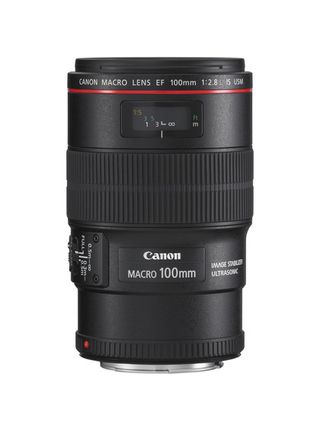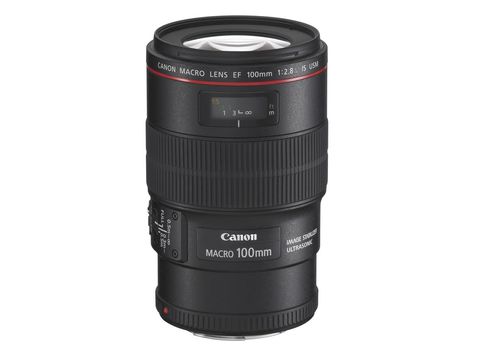TechRadar Verdict
Pros
- +
New Hybrid IS system
- +
Distance window is well positioned
- +
Weather-resistant
- +
Control over distortion is superb
Cons
- -
Focusing in lower light is slower than rivals
- -
Softness at edges is disappointing
- -
Chromatic aberrations a slight problem
Why you can trust TechRadar
Canon's EF 100mm F2.8 L Macro IS USM lens is the first to incorporate a new Hybrid IS system, which corrects for both rotational and linear camera shake. The new technology builds on the company's widely-employed Image Stabilizer, and is said to be particularly effective for subjects shot at close distances, which, according to Canon, is traditionally where standard image stabilisation systems struggle.
Its effectiveness is dependent on shooting distance, with a claimed two-stop improvement when the lens is used at its 1:1 magnification ratio, rising to four stops when used for more conventional photography. As with Canon's more standard stabilisation system, this is activated via a switch on the barrel, which sits above two further switches for autofocus/manual focus and limiting focus.

Sharpness test


Centre sharpness throughout the aperture range is high, with excellent results at f/2.8 and good results further down between f/8 and f/16.
Fringing test

Fringing is low in the centre of the frame but poorly controlled the further you get towards the edges.
Distortion test

Control over distortion is superb, with practically no distortion visible throughout images and only a negligible amount measured through lab testing.
The latter is notable for its three settings, which enable the user to specify focus between 0.3 and 0.5m or 0.5m and infinity, in addition to the entire range.
Canon has devoted a significant proportion of the outer barrel to a large focusing ring, which sits in the centre of the lens just ahead of the three switches.
Above it, there's a distance window that indicates distance in feet and metres, as well as the current magnification ratio. Usually this is found behind the focusing ring towards the rear of the lens, but by placing it here it's actually easier to view from behind the camera. The window itself is sufficiently large for all its information to be clearly laid out, which makes a refreshing change from countless other lenses whose poky distance windows make reading the information within them more difficult.
As with other Canon L-series lenses, a red ring encircles the top of the optic, and seals are in place to keep out any moisture and dirt. As its likely applications include nature photography, this is most welcome here, and means that the lens can be used with confidence with weather-resistant bodies such as the Canon EOS 5D Mk II and EOS 7D.
On the inside, a ring Ultrasonic Motor (USM) promises high-speed, near-silent autofocus, and focus may be manually overridden once the AF system has acquired a lock on a subject.
With an impressive nine diaphragm blades, the lens also looks well equipped for pleasing circular bokeh, while a single Ultra Low Dispersion (UD) element is also included to "effectively remove chromatic aberration". This is in addition to Canon's Super Spectra coatings, which are said to aid light transmission.
The focusing ring is perhaps a little stiffer than expected, but this doesn't make it particularly difficult to turn and it runs smoothly from one end to the other. Its positioning towards the front of the lens means that when shooting handheld it's difficult to use the palm of your hand to support the camera's base, although when autofocusing this is less of an issue (and when using a tripod, it isn't one at all).
When there's enough light, focusing speeds are about as fast as expected. On an EOS 600D body there's some slight hesitation as focus is confirmed, but this will vary between DSLRs and is partially dependent on the ambient light available.
Focusing speed is still fast overall, although in lower light there's a noticeable slowdown in focusing speed as the camera moves more cautiously through its range, much more so than with similar optics.
In terms of results, on an APS-C body, corner shading disappears by around f/4, although on a Canon EOS 5D Mk II some darkening remains until f/5.6. Centre sharpness throughout the range is high, with excellent results at f/2.8 and good results further down between f/8 and f/16.
The one area where the lens noticeably falls behind its competitors, however, is in its consistency across the frame – softness towards the edges of the frame is disappointing, particularly at wider apertures, but this does improve as the aperture gets smaller.
A similar performance is witnessed with chromatic aberrations, which are low in the centre of the frame but poorly controlled the further you get towards the edges. Conversely, control over distortion is superb, with practically no distortion visible throughout images and only a negligible amount measured through lab testing.
Thankfully, the Hybrid IS system works well, with an average benefit of between two and three EV stops. A handful of images shot at slower shutter speeds also resulted well, and no doubt these would be deemed usable for all but critical work, although this was only generally achievable in more controlled indoor conditions, such as when sitting down and not being subject to any wind or other environmental conditions.
Verdict
The CanonEF 100mm F2.8 L Macro IS USM is a reasonably priced lens with sometimes excellent sharpness, an effective image stabilisation system and near-perfect control over distortion. It has all the features you could realistically want for a macro lens, and its only failings are slightly inconsistent sharpness across the frame and sub-standard control over chromatic aberrations.

